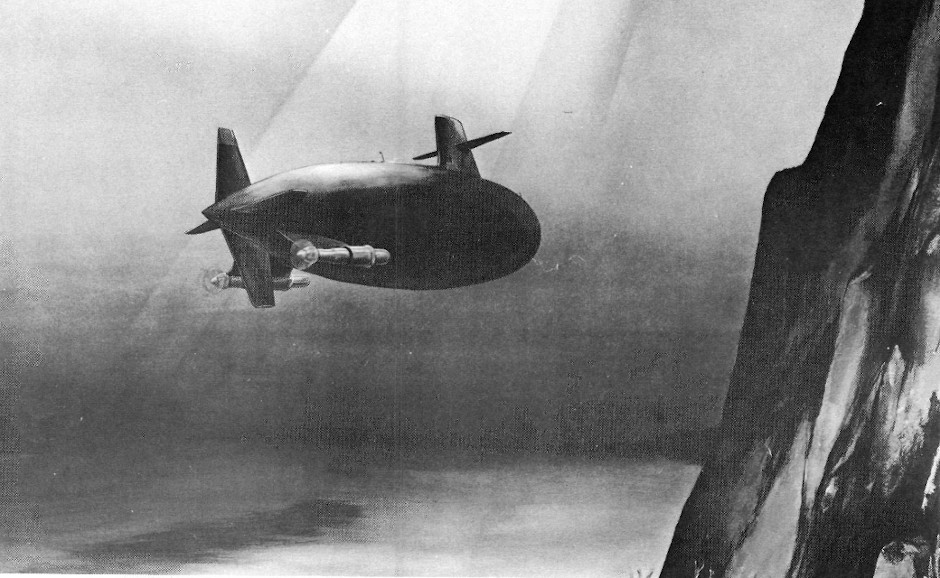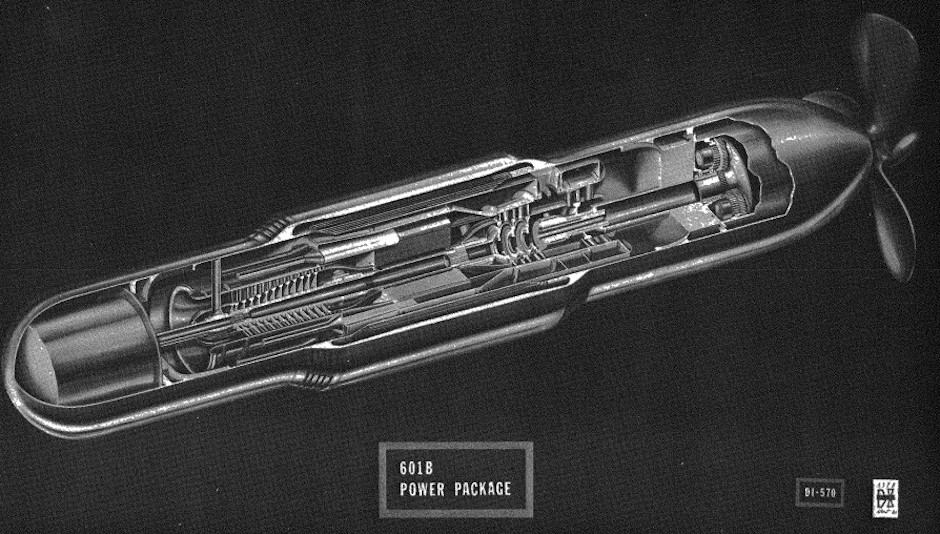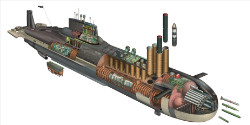Nuclear power pod concept for submarines (US Navy, 1961) In the early 1960s General Electric (GE) proposed a podded nuclear power system for submarines and surface ships. These outboard motors were termed it a nuclear power package. The 'package' was intended as a lightweight single use system which could be replaced once the fuel was expended. For submarines, a 15,000 hp version would weight 215 tons, and a 30,000 hp version would weigh 245 tons.
In the early 1960s General Electric (GE) proposed a podded nuclear power system for submarines and surface ships. These outboard motors were termed it a nuclear power package. The 'package' was intended as a lightweight single use system which could be replaced once the fuel was expended. For submarines, a 15,000 hp version would weight 215 tons, and a 30,000 hp version would weigh 245 tons.

The idea was born from the project to build nuclear powered aircraft. That hugely expensive program was eventually abandoned in the 1960s.
It was proposed for several scenarios:
1. Escorts and submarines, especially those of long range (compared to conventional ships), small size (compared to current nuclear vessels), and adequate military payload.
2. Hydrofoils, particularly those with long range and increased payload compared to their fossil-fueled counterparts.
3. Commercial vessels; the advantages of this power plant in weight and compactness also indicated the possibility of cost savings in the field of commercial vessels, although additional application studies in this area were still required.

The package would allow for relatively small nuclear submarines which would inherently be cheaper to build. Presumably it would remove the need for a reactor compartment and propulsion space inside the submarine. This could easily half the physical size of the sub's main body. The submarine would still need power for other uses, and the outboards might not be enough, so possibly a small reactor would still be present inside the hull.
Get The essential guide to World Submarines
This Covert Shores Recognition Guide Covers over 80 classes of submarines including all types currently in service with World Navies.Check it out on Amazon
There is some correlation between size and cost and the first generation of nuclear subs were becoming expensive to build. So the US Navy had been giving serious consideration to small submarines at the time.
GE studied the potential size reduction in the Skipjack Class submarines then being built. Taking into consideration an additional 110 tons required for emergency propulsion, the 601B propulsion-system would be 215 tons for 15, 000 horsepower. This was a reduction of 550 tons, or about 20 percent of ship weight without water and lead. This weight decrease would produce other reductions (e. g., hull structure), so that a design might be as small as 2000 to 2500 tons. This reduction in size may actually be more significant than reduction in propulsion system weight.

The podded propulsion package could have reduced the weight of the US Navy's Skipjack Class by about 1,000 tons.
And since most of the weight of the 601B propulsion system was in emergency power and controls, the power could be doubled without incurring a large penalty; e. g., 30, 000 horsepower can be generated by a system weighing 245 tons, only 30 tons more than the 15, 000-horsepower system. A 2000-ton attack submarine with this power would have a speed of approximately 38 knots.
The ultimate book of Special Forces subs Covert Shores 2nd Edition is the ONLY world history of naval Special Forces, their missions and their specialist vehicles. SEALs, SBS, COMSUBIN, Sh-13, Spetsnaz, Kampfschwimmers, Commando Hubert, 4RR and many more.
Check it out on Amazon
The podded format used the seawater between the pod and the hull as shielding. GE wrote "mobile nuclear power systems should use geometry and environment as shielding to the maximum permissible extent. For example, it would be desirable to use sea water as a shield in marine applications." About 5 feet separation was considered sufficient.

Another idea was to use the technology in deep-diving submarines. In this high-pressure environment compactness was especially desirable to lessen the structural problems. So the advantages of decreased power-plant size became apparent.
The World's ONLY Guide to
Narco Submarines
10 years of research, analyzing over 160 incidents, condensed into a handy guide. This unique book systematically breaks down the types and families. With detailed taxonomy, recognition 3-views, profiles and photos. Available on Amazon
The project wilted and died. It was before the subsafe program, and also just before the US Navy took on board the importance of quietening. We can guess that these podded packages would have been noisy and would have irradiated every port they pulled into. Perhaps it's for the best that this ingenious idea never took off.
Related articles (Full index of popular Covert Shores articles)

 USS Jimmy Carter (SSN-23) Special Mission submarine
USS Jimmy Carter (SSN-23) Special Mission submarine

 Sweden's nuclear powered submarine project (A-11A)
Sweden's nuclear powered submarine project (A-11A)

 TYPHOON Class SSBN
TYPHOON Class SSBN

 Barbel Class - the last front-line diesel boats int the US Navy
Barbel Class - the last front-line diesel boats int the US Navy

 SIERRA-I Class SSN
SIERRA-I Class SSN

 SIERRA-II Class SSN
SIERRA-II Class SSN

 USS Halibut
USS Halibut

 USS Seawolf (SSN-575)
USS Seawolf (SSN-575)

 First DDS - Type-IIIA U-Boat
First DDS - Type-IIIA U-Boat

 SDV Mk.9 SEAL Delivery Vehicle
SDV Mk.9 SEAL Delivery Vehicle






